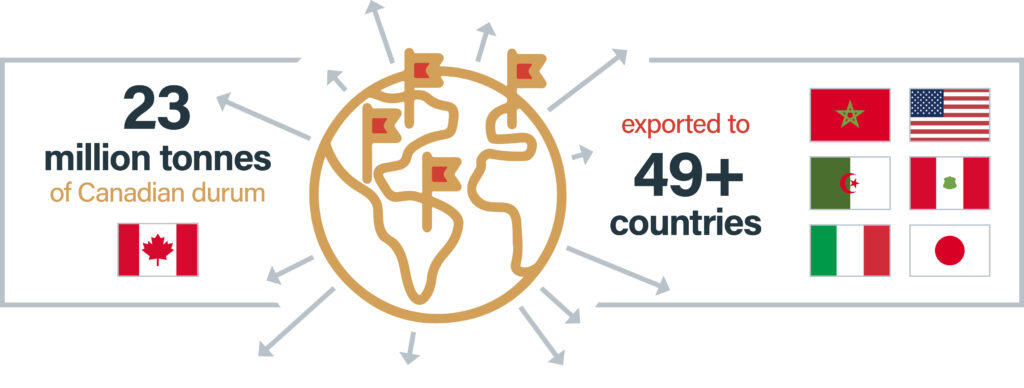
Canadian Durum Wheat
Locally Grown, Globally Renowned
Renowned for its quality, Canada Western Amber Durum (CWAD) is in demand around the world. Over the last five years, over 23 million tonnes of Canadian durum was exported to 49 countries, including Morocco, Algeria, Italy, the United States, Peru, and Japan.

Grown exclusively in the prairie provinces, CWAD accounts for over half of the world’s durum exports. Its superior yellow colour, high protein content, good gluten quality, and high semolina yield make it a prized wheat for the production of pasta.
CWAD provides the beautiful, bright yellow colour and satisfying firm texture that pasta makers—and pasta lovers—look for.
Facts About Canadian Durum and Pasta Around the World
- Durum has the hardest kernel of the wheat varieties, and its name means “hard” in Latin.
- Before it can be made into pasta, durum is milled into semolina, a coarsely textured flour.
- Pasta originated in China, not Italy, with the first reports of people eating pasta going back as far as 5,000 B.C.
- Canadians love pasta! In 2020, the per capita consumption was estimated to be 7.9 kilograms.
In general, wheat-based foods that are higher in whole grains and dietary fibre have a lower glycemic index, but pasta is a unique example of a refined wheat food that has a low glycemic index.
Canadian Durum—A Healthy Choice for Your Family
Not only are foods made with Canadian durum delicious, they’re nutritious, too. Wheat provides a variety of important vitamins and minerals to our diet, including dietary fibre, protein, B vitamins (thiamin, riboflavin, niacin, vitamin B6, folate), iron, copper, zinc, magnesium, vitamin E, selenium, manganese, phosphorous, potassium, and more.

Look for pasta made with 100% Canadian durum—check the label or ask your retailer.
It is estimated there are over 600 shapes of pasta, and their names are usually Italian words that playfully describe their shape. For example, penne means “pens” or “quills,” orecchiette means “little ears,” and spaghetti means
“little strings.” See the chart below for some popular pasta shapes that you might find at your local grocery store or specialty retailer.

How to Cook Canadian Durum Pasta
DID YOU KNOW?
Al dente (Italian for “to the tooth”) is the preferred way of cooking pasta. When cooked al dente, pasta should be tender but still firm to the bite.
COOKING DIRECTIONS
- Always use plenty of water when cooking pasta—about one litre of water for every 100 g of pasta—and use a large pot to allow the pasta plenty of room to cook properly.
- Bring water to a boil.
- Add a generous pinch of salt.
- Gently add pasta and stir. Do not cover.
- Cook for the time indicated on the package, maintaining a gentle boil.
- When pasta is done, drain thoroughly and serve with your favourite sauce.
HOW TO CHECK FOR DONENESS
The simplest way to check your pasta for doneness is to carefully remove a couple pieces from the boiling water, let them cool slightly, and taste them. If your teeth meet a slight bit of resistance, your pasta is al dente.
Pasta made with durum wheat is a low glycemic index food.
You may think pasta causes a “sugar spike” after eating since it is a carbohydrate-rich food. But in fact, the gluten in durum wheat pasta creates a compact structure which makes the pasta harder for the enzymes in our digestive system to break down. This slows the digestion and breakdown of the carbohydrates in the pasta and therefore slows the absorption of glucose into our blood. The longer and harder our body has to work to break down the carbohydrates into sugar, the longer it will take for these sugars to be released and absorbed into our bloodstream.
